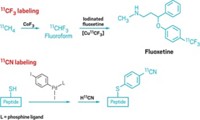Advertisement
Grab your lab coat. Let's get started
Welcome!
Welcome!
Create an account below to get 6 C&EN articles per month, receive newsletters and more - all free.
It seems this is your first time logging in online. Please enter the following information to continue.
As an ACS member you automatically get access to this site. All we need is few more details to create your reading experience.
Not you? Sign in with a different account.
Not you? Sign in with a different account.
ERROR 1
ERROR 1
ERROR 2
ERROR 2
ERROR 2
ERROR 2
ERROR 2
Password and Confirm password must match.
If you have an ACS member number, please enter it here so we can link this account to your membership. (optional)
ERROR 2
ACS values your privacy. By submitting your information, you are gaining access to C&EN and subscribing to our weekly newsletter. We use the information you provide to make your reading experience better, and we will never sell your data to third party members.
Radiochemistry
Fluoride-swapping reaction offers speedy way to make radiochemicals
Molecules with fluorine-18 labels are ready for PET imaging in less than 2 min
by Bethany Halford
March 2, 2021

A swift fluoride switcheroo lets chemists transform aryl fluorosulfate molecules into potential radiotracers for positron emission tomography (PET) in less than 2 min. The reaction, known as [18F]SuFEx, offers a way to make and purify a wide variety of radiochemicals faster than previous methods—a huge boon for a field where chemists are always racing against the radiolabeled compound’s half-life. PET imaging lets scientists make maps of the brain or cancers by following the uptake of molecules labeled with gamma ray-emitting atoms, particularly fluorine-18. Fluorine-18 has a 110-min half-life, so chemists have to work quickly to synthesize, purify, and use radiotracers before the isotope decays to the point that it is no longer a useful beacon.
A team led by K. Barry Sharpless and Peng Wu of Scripps Research in California and Guang Yang of ShanghaiTech University discovered they could exchange the fluorine-19 in aryl fluorosulfate-tagged molecules with fluorine-18 in a reaction that takes about 30 seconds (J. Am. Chem. Soc. 2021, DOI: 10.1021/jacs.0c09306). The molecules can be purified prior to the exchange, so after the fluoride swap the chemists can use a cartridge to quickly separate the molecule from the reagents necessary for the reaction. Compared to radiolabeling reactions that form a C–F bond, [18F]SuFEx is faster, has a simpler purification, and can be done on a wider array of complex molecules, Sharpless says.
Other chemists have tried a similar fluorine swapping approach with B–F or Si–F bonds, says Jacob Hooker, a molecular imaging expert at Massachusetts General Hospital and Harvard Medical School who was not involved in the work. Those efforts failed because those bonds readily react with water. Despite what chemical intuition tells us, that’s not the case with the aryl fluorosulfates, Wu says. These groups don’t readily react, which makes the fast fluoride exchange something of a surprise.
“The method is unique and balances simplicity and practical considerations of PET radiochemistry with solid physical organic chemistry theory and data underlying the design concept,” Hooker says in an email. “I suspect this work might inspire other ideas that will continue making PET radiochemistry more tractable.”
Qinheng Zheng, who worked on the reaction while he was a graduate student in Sharpless’s lab, points to [18F]SuFEx’s ability to turn a wide variety of molecules into radiochemicals, which could lead to targeted probes for specific cancers. To demonstrate this, the researchers made an aryl fluorosulfate derivative of the ovarian cancer drug olaparib labeled with fluorine-18 (shown) and then used it to visualize tumors in mice. Zheng says small-molecule tags with aryl fluorosulfate groups could be attached to large biological molecules, like antibodies, further expanding [18F]SuFEx’s use.




Join the conversation
Contact the reporter
Submit a Letter to the Editor for publication
Engage with us on Twitter